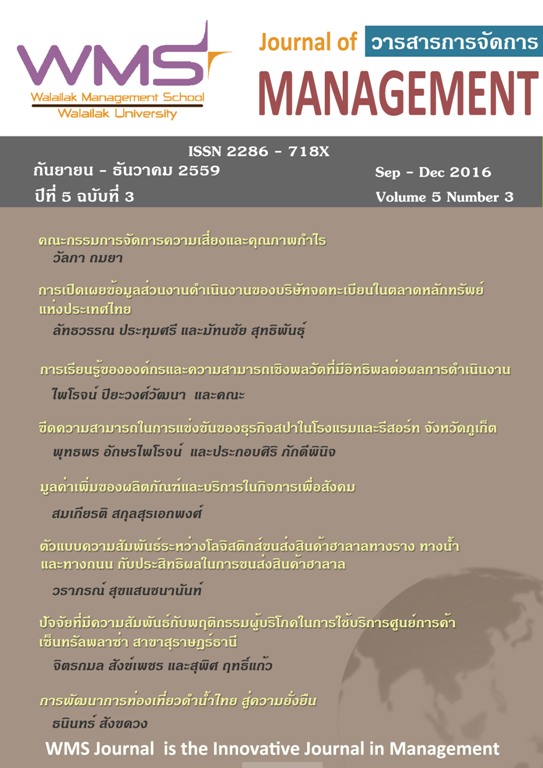Organizational Learning and Dynamic Capability Influencing Organizational Performance
Main Article Content
Abstract
Article Details
References
ยุทธศาสตร์ เป้าหมาย และตัวชี้วัด กระทรวงสาธารณสุข ประจำปี 2558. สืบค้นเมื่อ 22 กุมภาพันธ์ 2558, สืบค้นจาก http://www.hfocus.org/database/2014/09/8236
สิทธิศักดิ์พฤกษ์ปิติกุล. 2555. บริหารโรงพยาบาลสู่ความเป็นเลิศด้วย TQA. กรุงเทพฯ: ภาพพิมพ์.
สำนักนโยบายและยุทธศาสตร์ สำนักปลัดกระทรวงสาธารณสุข. สืบค้นเมื่อ 2 มิถุนายน 2557, สืบค้นจากhttp://www.moph.go.th
Ali, S., Peters,L.D. &Lettice,F. (2012). An Organizational Learning Perspective on Conceptualizing Dynamic and Substantive Capabilities. Journal of Marketing, 20(7): 589-607.
Argyris, C. &Schon.D.(1978). Organizational Learning. M.A.: Addison-Wesley,Reading.
Barney, J. (1991). Firm resources and sustainable competitive advantage. Journal of Management, 17(1): 199-120.
Bose, R. (2003). Knowledge Management-enabled Health care Management Systems: Capabilities, Infrastructure,and Decision Support. Expert Systems with Applications, 24(59-71).
Crossan, M. M. &Berdrow,I. (2003). Organizational Learning and Strategic Renewal.Strategic Management Journal, 24(-): 1087-1105.
Diamantopoulos, A. &Siguaw,J. (2000). Introducing LISREL Great Britain: Athenaeum Press.
Drnevich, P. &Kriauciunas, A.P. (2011). Clarifying the Conditions and Limits of the Contributions of Ordinary and Dynamic Capabilities to Relative Firm Performance. Strategic Management Journal, 32(254-279).
Eisenhardt, K. & Martin, J. (2000). Dynamic Capabilities: What are They? Strategic Management Journal, 21(10/11): 1105-1121.
Enz, C. A., Canina, L. &Walsh, K. (2001). Hotel-Industry Averages: An Inaccurate Tool for Measuring Performance. Cornell Hotel & Restaurant Administration Quarterly, 42(6): 22-32.
Garcı´a-Morales, V.J.,Llorens-Montes, F.J.&Vedu-Joyer, V.J. (2006). Antecedents and Consequences of Organizational Innovation and Organizational Learning in Entrepreneurship. Industrial Management&Data, 1(-): 21-42.
Hubbard, G., Zubac, A.,&Johnson, L. (2008). Linking Learning, Customer Value and Resource Investment Decisions:Developing Dynamic Capabilities. Advances in Applied Business Strategy,10(-): 9 - 27.
Huber, G. P. (1991). Organizational Learning: The Contributing Processes and Literatures. Organization Science, 2(1): 88-115.
Jadad, A. R., Haynes, R.B., Hunt, D. &Browman, G.P.(2000). The Internet and Evidence Based Decision Making: A Needed Synergy for Efficient Knowledge Management in Health Care. Canada Medical Association Journal, 162(3): 362-365.
Jantuen, A., Ellonen, H-K.&Johansson,A. (2012). Beyond appearances - Do dynamic capabilities of innovative firms actually differ. European Management Journal, 30(-): 141-155.
Kaplan, R. S. &Norton, D. P. (2004).Measuring the Strategic Readiness of Intangible Assets. Harvard Business Reviews, 82(2): 52-63.
Kogut, B. Z. &Zander, U. (1992). Knowledge of the Firm, Combinative Capabilities, and the Replication of Technology. Organization Science, 3(3): 383-397.
Kuo, T.-H. (2011). How to Improve Organizational Performance Thought Learning and Knowledge? International Journal of Manpower, 32(5/6): 586-603.
López, S. P., Peón, J. &Ordás,C. (2005). Organizational Learning as a Determining Factor in Business Performance.The Learning Organization, 12(3): 227.
McKelvie, A. &Davidsson, P. (2009). From Resource Base to Dynamic Capabilities: an Investigation of New Firms. British Academy of Management, 20(-): s63-s80.
Nonaka, I. &Takeuchi, H. (1995).The Knowledge-Creating Company. New York: Oxford University Press.
Porter, M. E. (1985). Competitive Advantage: Creating and Sustaining Superior Performance. New York: Free Press.
Santos-Vijand, M., Lopez-Sanchez.&Trespalacios, Juan Antonio.,. (2012). How Organizational Learning affects a Firm's Flexibility, Competitive Strategy, and Performance. Journal of Business Research, 65(-): 1079-1089.
Senge, P. &Sterman,J. 29-31, May (1990). Organizational learning culture—the missing link between business process change and organizational performance. Paper presented at the Sloan School of Management, Massachusetts Institute of Technology ,Cambridge.
Senge, P., Kliener, A., Roberts, C., Ross, R. &Smith, B.,. (1994). The Fifth Discipline Field book NewYork: Doubleday Durrency.
Song, J., Jeung, C-W.&Cho,S. (2011). The Impact of the Learning Organization Environment on the Organizational Learning Process in the Korean Business Context. The Learning Organization, 18(6): 468-485.
Teece, D. J., Pisano, G. &Schuen, A. (1997). Dynamic Capabilities and Strategic Management. Strategic Management Journal, 18(7): 509-533.
Teece, D. J. (2007).Explicating Dynamic Capabilities: The Nature and Micro foundations of (Sustainable) Enterprise Performance. Strategic Management Journal, 28(13): 1319-1350.
Teece, D. J. (2012). Dynamic Capabilities: Routines versus Entrepreneurial Action. Journal of Management Studies, 49(8): 1395-1401.
Voelker, K.E.,Rakich, J.S., & Richard, F.G.(2001). The balanced scorecard in healthcare organizations: A performance measurement and strategic planning methodology. Hospital Topics, 79(3), 13-24.
Winter, S. G. (Ed.). (1994). Organizing for Continuous Improvement:Evolutionary Theory meets the Quality Revolution,in J.Bum and J.Singh: Oxford University Press:Oxford.
Wu, I., &Hu,Y. (2012). Examining Knowledge Management Enabled Performance for Hospital Professionals: A Dynamic Capability View and the Mediating Role of Process Capability. Journal of the Association for Information Systems, 13(12): 976-999.
Yamane, T. (1967). Elementary sampling theory. Englewood Cliffs, NJ: Prentice-Hall.
Zelman, W.N., Pink, G.H. & Matthias, C.B. (2003).Use of the Balanced Scorecard in Healthcare. Journal of Healthcare Finance, 29(4), 339-351


